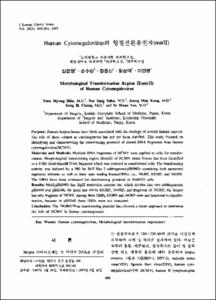Human Cytomegalovirus의 형질전환유전자(mtrII)
- Keimyung Author(s)
- Sohn, Soo Sang; Kang, Joong Shin; Chang, Sung Ik; Lee, In Hwan
- Department
- Dept. of Surgery (외과학)
Dept. of Anatomy (해부학)
- Journal Title
- 대한암학회지
- Issued Date
- 1997
- Volume
- 29
- Issue
- 3
- Abstract
- Purpose: Human herpesviruses have been associated with the etiology of several human cancers. The role of these viruses in carcinogenesis has not yet been clarified. This study focused on identifying and characterizing the transforming potential of cloned DNA fragments from human cytomegalovirus(HCMV).
Materials and Methods: Multiple DNA fragments of HCMV were applied to cells for transformation. Morphological transforming region II(mtrII) of HCMV strain Towne has been identified to a 3.0kb Xbal-BamHI DNA fragment which was retained in transformed cells. The transforming activity was induced by a 980 bp Ball-Xho I subfragment(pBS980) containing both promoter/ regulatOTy elements as well as three open reading frames(ORFs), i.e., 790RF’ 830RF, and 340RF. The ORFs have been evaluated for transforming potential in NIH3T3 cells. Results: MtrII(pBS980) has Bglll restriction enzyme site which divides into two subfragments, pBS440 and pBS540, the latter has whole 830RF, 340RF, and fragment of 790RF, the former has only fragment of 790RF. Among three ORFs, 830RF and 340RF were not functional in transformation, because in pBS540 these ORFs were not truncated.
Conclusion: The 790RF(79-aa transforming peptide) has allowed a better approach to determine the role of HCMV in human carcinogenesis.
- Alternative Title
- Morphological Transformation Region II(mtrII) of Human Cytomegalovirus
- Publisher
- School of Medicine
- Citation
- 신연명 et al. (1997). Human Cytomegalovirus의 형질전환유전자(mtrII). 대한암학회지, 29(3), 495–503.
- Type
- Article
- ISSN
- 0496-6872
- Appears in Collections:
- 1. School of Medicine (의과대학) > Dept. of Anatomy (해부학)
1. School of Medicine (의과대학) > Dept. of Surgery (외과학)
- 파일 목록
-
-
Download
 oak-bbb-02742.pdf
기타 데이터 / 583.95 kB / Adobe PDF
oak-bbb-02742.pdf
기타 데이터 / 583.95 kB / Adobe PDF
-
Items in Repository are protected by copyright, with all rights reserved, unless otherwise indicated.